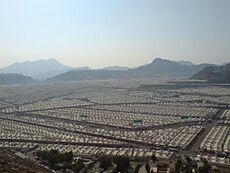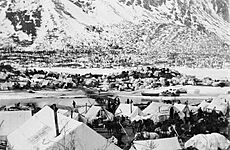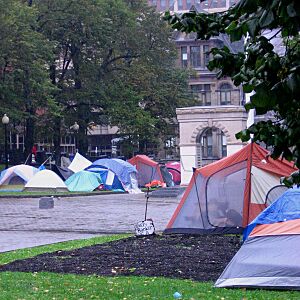Tent city facts for kids
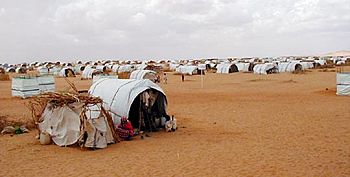
A tent city is a temporary housing facility made using tents or other temporary structures.
State governments or military organizations set up tent cities to house evacuees, refugees, or soldiers. UNICEF's Supply Division supplies expandable tents for millions of displaced people.
Informal tent cities may be set up without authorization by homeless people or protesters.
Tent cities set up by homeless people may be similar to shanty towns, which are informal settlements in which the buildings are made from scrap building materials.
Shoddy and lower-condition tent cities may be considered skid rows or a facet of them.
Contents
- Military
- Environmental disasters
- Homeless people
- Canada
- United States
- Philadelphia, Pennsylvania
- Camp Hope: Las Cruces, New Mexico
- Second Chance Village: Akron, Ohio
- California
- Minneapolis, Minnesota
- St. Petersburg, Florida
- Olympia, Washington
- Seattle, Washington
- King County, Washington
- Transition Park, Camden, New Jersey
- Potomac Mills, Woodbridge, Virginia
- Other locations
- Events
- Other applications
Military

In the military, the term "tent city" usually refers to temporary living quarters erected on deployed military bases, such as those found in Bosnia and Herzegovina or Iraq. Depending on the branch of service and the length of time the tent city has been in place, the living space may be equipped with most modern amenities. For sanitary reasons, military tent cities place toilet, shower, and laundry facilities at least 50 feet (15 m) from living quarters. Also, tents are typically divided into clusters of 8–10 to prevent the rapid spread of fire, which is of utmost concern because of the tent and bedding materials.
Environmental disasters
Since Hurricane Katrina made landfall in August 2005, the term has been used to describe temporary housing sites set up for Gulf Coast residents who were left homeless by the storm. Some of the tents that were built by Seabees and funded by the U.S. Federal Emergency Management Agency (FEMA) are wooden structures covered by tents. With the exception of indoor plumbing, most of the tents have heat, air, and lights. The tent city can hold as many as 250 occupants. Displaced residents are only expected to stay for three to six months.
Homeless people
Canada
Toronto, Ontario
Toronto, Ontario, Canada's largest city, was also home to its own "Tent City" until September 2002, when the residents of Tent City were evicted by the owner of the property, Home Depot. It was situated in the downtown core of Toronto, near the waterfront, and was home to hundreds of people who were homeless. Toronto introduced rent supplement programs in the following year (2002–2004) by which 115 residents were given access to mainstream apartment units. Journalist Shaughnessy Bishop-Stall voluntarily abandoned his middle class lifestyle to live in Tent City for a year. He detailed his experiences in his 2005 book, Down to This: Squalor and Splendour in a Big-city Shantytown.
During the Covid-19 pandemic, the city also witnessed a revival of tent cities in its public parks.
United States
Philadelphia, Pennsylvania
Tent cities have long been a part of Philadelphia's history. The steadily growing number of encampments have been passed down by multiple administrations—from Mayor Wilson Goode (1984 to 1992) to the present-day Mayor Kenney (2015–present). The collection of encampments developed for multiple reasons. Some started as contained protests for affordable housing, others were attempts to establish more secure living through a developed community.
When assessing the number of homeless people in Philadelphia, the Office of Homeless Services counted 958 people living in the streets. Non-profit organizations like Project H.O.M.E have made efforts to help by, "providing housing, opportunities for employment, medical care, and education to homeless and low-income persons in Philadelphia, Pennsylvania."
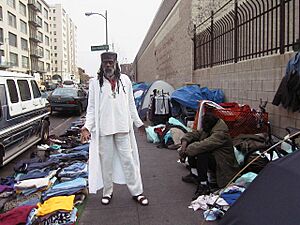

Camp Hope: Las Cruces, New Mexico
Camp Hope is an alternative transitional living project, for the homeless, in the form of camping. It is located on the Mesilla Valley Community of Hope (MVCH) campus and is an alliance of agencies that address homelessness in Las Cruces, New Mexico. The tent city can house 50 people that would otherwise be on the streets, providing them a safe place to seek direct services, healthcare, and find jobs and housing. Camp Hope has provided the homeless with the opportunity to be right next to all the Direct Services the agencies on the MVCH campus provide.
The camp was founded in November 2011 with temporary permission from the city of Las Cruces. The camp was supposed to disband in March 2012, but there was no funding available to build another shelter and the City Council stated that the tent city benefited the city.
In 2013, with help from engineering students from New Mexico State University, the site was rezoned as a planned unit development (PUD) that sanctioned a permanent campground along with a number of other uses on the non-profit's campus.
Second Chance Village: Akron, Ohio
This service club made of homeless and formerly homeless members was founded by Ryan Scanlon and once laid their tent city operations in the rear of private property owned by Sage Lewis LLC in the Middlebury area of Akron, Ohio, from January 2017 until January 2019. It was known as Second Chance Village and still exists operating as a nonprofit service club organization in secret locations splintered amongst the cityscape.
Akron City Council rejected Mr. Lewis's request for a zoning exception on an 8-to-4 vote in September 2018.
All tents were forced to be removed by January 5, 2019.
California

Homelessness in California is a serious issue, if going by the per capita rate in 2020 of homelessness which ranks third in the US behind New York and Hawaii. 0.4% or more of Californians are homeless, and most major cities have homeless populations hovering around 0.5–1% of the city's population. This includes both sheltered and unsheltered homeless. Tent cities are prevalent in Tenderloin, San Francisco and Skid Row, Los Angeles.
The BBC did a news story, which talked about how the causes of the crisis in the U.S. economy has forced many people, who used to own their own homes, to now live in tents.
AlterNet published a story in 2009 about the mainstream media finally "discovering" the homeless situation in Sacramento.
Minneapolis, Minnesota
Minneapolis experienced the emergence and growth of homeless encampments in the aftermath of the murder of George Floyd and resulting unrest, in mid 2020. The Minneapolis Park and Recreation Board had an experimental process to permit homeless encampments on city park property. Homeless encampments appeared at 44 park sites during the summer months. The park board closed all camps on January 7, 2021, and discontinued permits.
St. Petersburg, Florida
In late December 2006, homeless people formed an impromptu tent city on the St. Vincent de Paul property in the 1400 block of Fourth Avenue N. of St. Petersburg in Saint Petersburg, Florida when dozens of homeless moved off of public land across the street from the society. In early January 2007, city officials noted city codes that prohibit living in tents and gave the society one week to evict the occupants of the tent city.
Olympia, Washington
Camp Quixote, a homeless encampment began as a protest movement of homeless people and homeless advocates against criminalizing "anti-social" legislation that was passed by the city in January 2007—specifically referring to the ordinance restricting people from sitting on sidewalks. City officials ordered the camp to disband. The Olympia Unitarian Universalist Congregation offered the encampment sanctuary on its property, being familiar with the Seattle faith-based network of homeless encampments. What began as a protest surrounding homelessness quickly became a faith community protest. The church community protested the city's insistence of dismantling the community on the grounds that churches maintain a specific land use right that allows them to offer sanctuary to the poor (Religious Land Use and Institutionalized Persons Act, or RLUIPA). Eventually, the adversarial protest turned to negotiation with local municipalities, with new ordinances condoning Camp Quixote with specific regulations and a ninety-day limit; option to move to other faith communities' property. Because of the ardent support of a volunteer team PANZA, the tent city is soon to be transformed into permanent supportive housing, Quixote Village - winter 2013.
Seattle, Washington
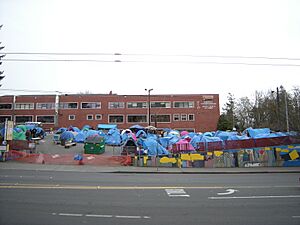
Homeless people have long resorted to seeking shelter in tents, but these communities are one of the first known to be organized by a sponsoring organization (a partnership between the Seattle Housing and Resource Effort and Women's Housing Equality and Enhancement League (SHARE/WHEEL)), and are one of the first in a major U.S. city to be largely accepted by local governments. Contrary to some stereotypes regarding the homeless, many residents of Tent City are employed, mostly in temporary or day labor jobs, but have insufficient income to obtain more permanent housing.
The original Tent City and Tent City 2, both created in the late 1990s, were created illegally and opposed by the City of Seattle. After being tolerated for some time, they were eventually forced to shut down. In March 2002, as a result of a legal battle, city attorney Tom Carr and SHARE/WHEEL attorney Ted Hunter signed a court ordered consent decree with SHARE, allowing Tent City only on private land (by invitation) and setting standards for its operation.
Another homeless encampment, unaffiliated with Tent City 3 and 4, lived in donated, mainly fuchsia, tents at the University Congregational United Church of Christ in Seattle's University District for several months ending March 5, 2009, at which time it moved to the suburb of Bryn Mawr south of Seattle. According to homeless advocates, residents criticized Seattle Mayor Greg Nickels for continuously clearing out homeless encampments, and named their encampment "Nickelsville". The church itself, out of respect for recent efforts by Mayor Nickels, did not use the "Nickelsville" name in referring to the encampment.
While on the road in Seattle, Washington, on March 30, 2009, Democracy Now! covered a story about Seattle's Nickelsville. They also covered a story about the police raid on Nickelsville the previous day, March 29, where 24 people were arrested.
King County, Washington
Tent City 4 (TC4) is a homeless encampment of up to 100 people created in May 2004 in eastern King County outside of Seattle. Residents are adult men and women, although there is a provision for quartering minor dependents in emergency situations.
Transition Park, Camden, New Jersey
A community of 50 to 150 people had taken up residence in Camden, New Jersey, nestled on the right side of the ramp of I676 West exit 5A. Although attempts have been made to find housing for the population, no one in the community has been placed. Transition Park's Mayor and City Council continued to protect their community and seek medical attention for those in need. In May 2010, residents were forced out of the city and into local missions.
Under the leadership of Amir Khan, the pastor of Solid Rock Worship Center in Clementon, NJ, and founder of the Nehemiah Group, a faith-based nonprofit organization that Khan and his son Micah run, 54 residents of Tent City were moved to the Wingate by Wyndham Hotel in Mount Laurel in May 2010 with the help of volunteers. Pastor Khan asked his congregation and local business members for help and was able to raise $250,000 to provide some homeless people of Camden's Tent City with housing and human services for at least one year.
By September 13, 2010, 19 of the original 54 were removed from the "hotel program" and many former Tent City residents continue to move from one street corner or overpass to another, continuing the homelessness issue in Camden.
Potomac Mills, Woodbridge, Virginia
Since c. 2003, there exists a 10 acres (4.0 ha) tent city at Potomac Mills in Woodbridge, Virginia, adjacent to the Potomac Mills mall. It is tolerated by the private landlord. In 2018, part of the residents were directed to leave.
Other locations
Tent cities are also found in the following locations: Ann Arbor, Michigan; Chattanooga, Tennessee; Columbus, Ohio; Athens, Georgia; Atlanta, Georgia; Reno, Nevada; Sierra Vista, Arizona; Providence, Rhode Island: Sacramento, California; San Diego, California; Santa Rosa, California; San Francisco; San Jose, California; Oakland, California; Berkeley, California Lakewood, New Jersey; Lowell, Massachusetts; Huntsville, Alabama; Nashville, Tennessee; St. Louis, Missouri; Ft. Worth, Texas; and Buffalo, New York; Umoja Village, built by Take Back the Land, was a shantytown in Miami created to protest gentrification and a lack of low-income housing in Miami. Another tent city, called Tent City, was a temporary refugee center, constructed of bedsheets aboard Carnival Triumph during the infamous Carnival Triumph Fire of 2013, where power to the vessel was gone.
Events
1913 Gettysburg reunion

At the 1913 Gettysburg reunion, the United States Department of War set up a tent city that housed over 50,000 Civil War veterans.
Hajj
The Saudi Arabian government's Ministry of Hajj has set up a permanent tent city to house Muslim pilgrims in Mina, where the ritual Stoning of the Devil takes place as part of the overall Hajj pilgrimage to Mecca. A tent city is also set up at Mount Arafat, another essential stop during the Hajj. Because up to four million pilgrims may be performing the Hajj annually, the tent cities are densely inhabited with 20–40 people per tent. As such, fire and disease outbreaks were constant concerns. Since the late 1990s, Saudi authorities have started using fireproof tents to reduce the risks of a major fire.
Klondike and Nome Gold Rushes
During the Klondike Gold Rush in Alaska and Canada 1896–1899 several tent camps were built along the routes to the gold fields especially on the popular Dyea/Skagway route where it met Lake Bennett and Lake Lindeman the head of Yukon River. At the Nome Gold Rush, between 1899 and 1909, a tent city sprung up that was 30 miles long, on the beaches and on the treeless coast of Nome, Alaska between Cape Rodney and Cape Nome.
Persepolis
For the festivities of the 2,500 year celebration of Iran's monarchy the Shah of Iran, Mohammad Reza Pahlavi, built a luxurious tent city in the desert next to the ruins of Persepolis to accommodate his international guests. The event took place October 12–16, 1971. The tent city was inspired by the tent city of the Field of the Cloth of Gold meeting between Francis I of France and Henry VIII of England that took place in 1520.
Other applications
Fayette County, Tennessee
Tent City in Fayette County, Tennessee, United States, was an encampment for displaced blacks who were removed from their homes and blacklisted from buying amenities as retaliation for registering to vote in the early days of the Civil Rights Movement.
West Virginia University
Throughout the week of October 26 to November 1, 2014, hundreds of West Virginia University students camped out in "Tent City" prior to ESPN's College GameDay.
Kent State University
On May 12, 1977, a tent city was erected and maintained for a period of more than 60 days by a group of several dozen protesters on the campus of Kent State University in Kent, Ohio, United States. The protesters, led by the May 4 Coalition but also including community members and local clergy, were attempting to prevent the university from erecting a gymnasium annex on part of the site where the Kent State shootings occurred in May 1970, which they believed would alter and obscure that historical event. Law enforcement finally brought the tent city to an end on July 12, 1977, after the forced removal and arrest of 193 people. The event gained national press coverage and the issue was taken to the U.S. Supreme Court.
Music
Chicago band Patience Gloria's second album Consequences David has a song titled "Tent City Nation" that addresses the subject.
- Bolton Hall, activist who established a tent city in New York city in 1908
The area at music festivals for attendees to set up their tents for overnight stays is often called "Tent City".
Protests
- Occupy movement was an international protest movement that featured tent cities set up in parks in some cities.
Maricopa County Jail modification
Prior to the election of Sheriff Joe Arpaio in 1993, the prisoner population in Maricopa County Jail, Arizona, the fourth largest jail system in the world, exceeded the maximum number of inmates allowed in its facilities. Prisoners were routinely released from custody prior to completing their sentence due to the overcrowding. In a study conducted in 1993 it was estimated that construction of a new facility would cost approximately $70,000,000. Sheriff Arpaio, concerned about the cost of a new facility and reasoning that military tents were good enough for the men and women of the U.S. armed forces who fought in the Gulf War, ordered that tent jails be constructed using inmate labor. It consisted of Korean War–era tents donated by the United States armed forces, and a 50 feet (15 m) observation tower with a vacancy sign mounted on the front. The final cost of the project was approximately $100,000 and it was capable of housing over 2,400 inmates. Tent City was closed in October 2017.


